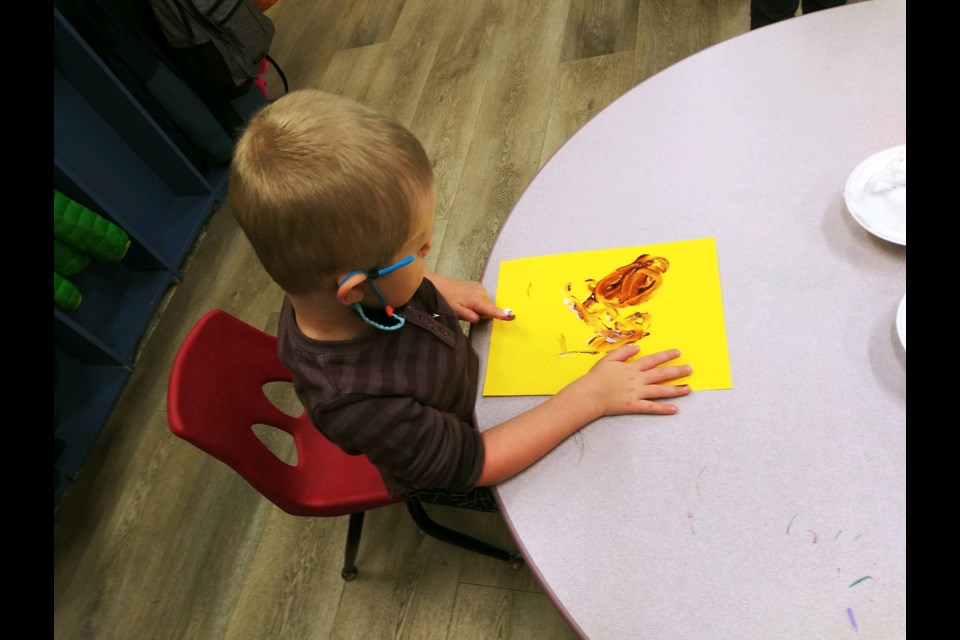Inspired by art that helps calm her, Kelly Gwin now shares her discovery of braille messy art with students. She also has found the genre to have larger educational benefits.
Gwin grew up in Longmont, graduating from Skyline High School in 1998, and shortly afterward became a CNA. After working and training at Applewood Living Center and entering the nursing field, her plans had to change. She became pregnant and sought an employment opportunity that didn’t require so much lifting. She discovered home healthcare.
Gwin stayed working in home healthcare for many years but found that the grief associated with working in that field weighed too heavily on her. Gwin struggles with anxiety and carries the diagnosis of ADHD — Attention Deficit Hyperactivity Disorder.
Following her true passion, Gwin always dreamed of adapting her compassion for others to teaching children. While she had some stints in childcare in earlier parts of her life, it took some time before she was able to stay in the field permanently. She found an opportunity to move into early childhood teaching full-time in January of 2020, joining the staff in the pre-K classroom at Here We Grow, Early Childhood Learning.
In her new position, as well as in her daily life,she found that sensory art helped her manage her anxiety and ADHD. She's using those personal insights to work with students who struggle with their emotional control, particularly those who get angry or sad easily.
"I love doing sensory art projects with the kids because it helps them calm down," Gwin said.
In addition to helping the kids with emotional control, Gwin found that sensory art provides an opportunity for those kids who struggle with attention to focus for longer periods of time.
"They spend more time on these types of art projects than on other ones we do like punch-out objects. While these are fun for the kids for a short time, they need more of a challenge," Gwin said.
Gwin researched different types of sensory art for children with ADHD and sensory processing disorders and followed that art to supplement the early childhood curriculum offered at the learning center.
"My choice in art projects depends on the day and, most importantly, on my kids' moods," she said.
Most often she chooses messy art. Gwin loves seeing the kids bring their visions to life through exploration and discovery. She enjoys letting them do their own thing, she said.
"I love to let the kids experiment with how they want their art to be and what they want it to look like," Gwin said.
One of Gwin's personal favorites is braille messy art. Braille messy art uses the raised lines and pictures of braille to encourage artistic creativity. Most often, the art pads provided are intended for painting. However, one of Gwin's students loves coloring, so she uses it that way with him.
While all the kids enjoy it, it's particularly helpful for kids with challenges, she said.
In her early education classes, Gwin found different projects to serve those students' needs. Given her own experience with learning differences and her own style of art, she felt it could apply well to her classroom needs.
Although there are many types of art that may help students with special needs, Gwin hasn’t kept every idea. But braille messy art stuck around, she said.
"I went online, researched projects to do with these students' concerns. I tried it the following day, if it works, I keep it, but if not, we move on," Gwin said.
In addition to the benefits of greater emotional control and better focus, this style of messy art supports Kindergarten readiness, some experts state.
In Pre Braille Implementation into Early Education: Tactile Activities to Introduce Braille Concepts to Kindergartners by Jaime Hilditch, a candidate for the Master of Design in Inclusive Design at Ontario College of Art and Design (OCAD), "Our analysis shows a strong correlation between pre braille activities and Kindergarten classroom teaching. Pre-braille activities work to build two-handed coordination, finger sensitivity, light touch, and dexterity and mobility..."
Braille messy art may also help develop literacy skills in young children. Gwin holds literacy skills as a high priority in her classroom as she helps her students prepare for elementary education.
According to Paths to Literacy, "Braille art can be a stepping stone to tactile graphics, using real objects and other tactile materials to reinforce the meaning of an image."
Understanding the meaning of an image goes a long way.
According to Sarah Balcazar, marketing and communications manager for Reading Partners, "Pictures provide visual clues to help us discover more about the narrative. Pictures show expressions, unwritten details, setting, and context that help us compare and contrast. These details allow us to analyze more complex details of character development. Illustrations can provide important background knowledge and offer contextual cues based on what’s happening in the story."


